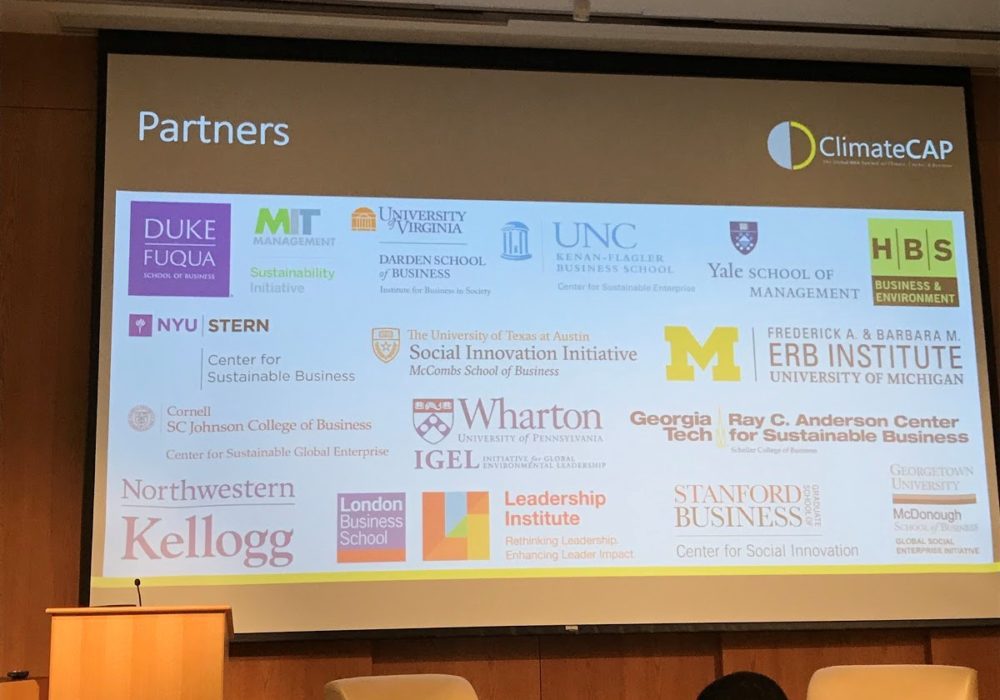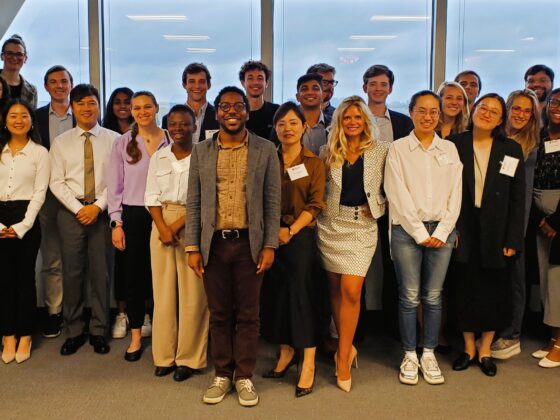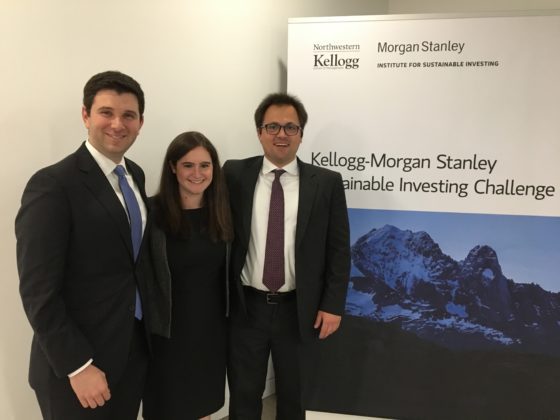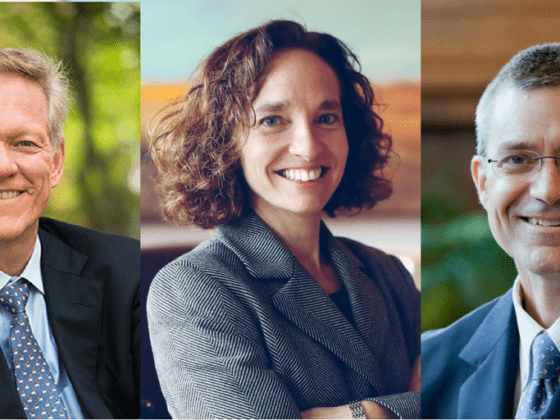By Lok (Neville) Chan and Eileen Cowdery (Darden School MBA ’18)
“This is not a forum for politics or policy solutions. We are not here to debate whether climate change exists. This is about business.”
These were the words of 2018 ClimateCAP Summit organizer and Managing Director of the Center for Environment, Development and Global Environment (EDGE) at the Duke Fuqua School of Business, Katie Kross, at this year’s first annual global MBA summit on climate, capital and business.
ClimateCAP brought together MBA students from 18 leading business schools to engage with business leaders and experts from all around the world at a two-day event held at the Duke Fuqua School of Business. The event featured panel discussions covering a range of business topics: finance, valuations, impact investing, venture capital, supply chain and leadership. Breakout discussions allowed students to further explore industry-specific interests in real estate, finance, food & agriculture, and apparel & consumer goods.
The summit was designed not to be a lecture-based, one-way communication style conference on climate change, but rather, as an open forum to increase participants’ understanding of the economics of climate change and where the hidden risks and opportunities lie for future business leaders.
With support from the Darden School Institute for Business in Society, we attended the 2018 ClimateCAP summit and are excited to share our insights from the experience:
The takeaway message from the summit could not have been any clearer. In business school, we are taught to master the quantitative and the verbal. We learn to apply complex valuation formulas and build intricate models to replicate decision making processes in business while learning to speak about business. In the case method, we often have the advantage of knowing what happened in the past – or as the phrase goes – ‘hindsight is 20/20.’
But what about the future? How can we take our valuation formulas and models derived from business events in the past and use them to shape the future?
Better yet, do these formulas and models even apply in the future? One consistent theme mentioned throughout the summit was – what will the world look like 40 to 50 years from now, and why should business school students care?
Tiiram Sunderland, a consultant from Bain & Company, touched on this question during his presentation. Sunderland argued that “an MBA education is incomplete without inclusion of classes focused around climate change and the risks it poses for business.” He stated that climate change will be one of the greatest threats to humankind over the next 40 to 50 years and Generation Y will be arguably the first generation to feel its full effects during our careers. These effects will impact, not only how we live our lives, but also forever redefine the business climate as we know it.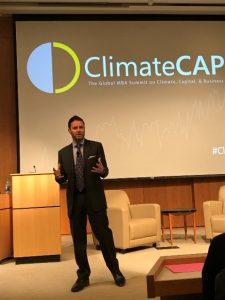
As MBA students, the key to mitigating the effects of climate change will be developing the ability to foresee its hidden risks and opportunities and to be action-oriented when faced with making business decisions in the future. Among the questions posed to the summit attendees were:
- What types of new industries will emerge as a result?
- How will climate change impact different countries? Industries?
- Which countries and industries will take the lead?
- What steps can we take to mitigate these risks?
- What are the economics behind every effect? Where is the money?
Institutional and public investors alike are starting to discover the financial opportunity in sustainable projects – and it’s not an altruistic crusade. Clients are demanding opportunities to invest in sustainable projects, which has given rise to new low carbon funds and green bond markets. There is no longer a tradeoff between sustainable and profitable, and sustainable finance is increasingly mainstream.
Valerie Smith, global head of corporate sustainability at Citi, spoke about the company’s commitment to provide $100 billion of environmental financing by 2023. Blackrock now has whole teams dedicated to sustainable finance, following CEO Larry Fink’s recent powerful letter to CEOs. However, green investing isn’t a get-rich-quick scheme. Many of these initiatives require time and scale to make lasting impact and profits.
“Short-term mindsets make it difficult to solve long-term problems. The Silicon Valley model doesn’t apply,” said Scott Jacobs, CEO and co-founder of Generate Capital.
Interestingly, there seemed to be a consensus among conference speakers that securing financing was no longer the issue; rather, lacking sustainable projects that need financing is the larger challenge.
Another topic of much conversation and focus was carbon pricing. Its concept is to hold organizations accountable for their carbon emissions and create an incentive system that rewards companies with lower emissions. The dialogue centered around three solutions: regulation, cap and trade, and carbon tax.
There are pros and cons to each of these, but the summit consensus seemed to be that a carbon tax would prove most effective in the long-run. Regulation is difficult to enforce, and cap and trade systems favor richer companies with the ability to purchase excess capacity. Arguments were made that a uniform carbon tax is more likely to bring about an overall reduction in emissions.
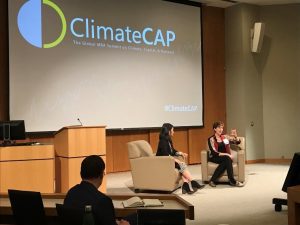 An apparel & consumer goods panel featured speakers from Nike, Levi Strauss & Co., Cotton Inc. and Ernst & Young. Among the speakers was Ms. Liza Schillo, manager of product sustainability at Levi Strauss & Co., who explained how the fashion industry could favor damaged articles of clothing, jeans with holes, as the new fashion “it item” for the upcoming season, but intentionally damaging jeans by creating holes in them would decrease the life expectancy of the jeans, drastically creating more waste for humankind. Similarly, Diane Holdorf, vice president & chief sustainability officer at Kellogg Company, spoke on the importance of recognizing the impact that food trends have on the types of food grocery stores stock, mentioning Kellogg’s role in encouraging consumption of more sustainable foods.
An apparel & consumer goods panel featured speakers from Nike, Levi Strauss & Co., Cotton Inc. and Ernst & Young. Among the speakers was Ms. Liza Schillo, manager of product sustainability at Levi Strauss & Co., who explained how the fashion industry could favor damaged articles of clothing, jeans with holes, as the new fashion “it item” for the upcoming season, but intentionally damaging jeans by creating holes in them would decrease the life expectancy of the jeans, drastically creating more waste for humankind. Similarly, Diane Holdorf, vice president & chief sustainability officer at Kellogg Company, spoke on the importance of recognizing the impact that food trends have on the types of food grocery stores stock, mentioning Kellogg’s role in encouraging consumption of more sustainable foods.
Where are the boundaries for a company in this situation? Should it capitalize on trends knowing fully well that the adoption of trends could be detrimental to the planet, or should it stick to its morals and only sell products that are environmentally considerate? As customers continue to become increasingly conscious of their impact on the environment, companies will have to make tough trade-offs, while maintaining disclosure and transparency into their business decisions.
To date, climate change is still seen as a question mark for many business school students. However, it was clear to us after attending the summit that more is needed: more discussions, brainstorming sessions, student-faculty partnerships, thought leaders in the same room, awareness, summits, informal gatherings, coffee chats and hallway talks.
Ultimately, more action must be taken.
We invite everyone to consider, and take action, on the following question – what more can you do to help mitigate the risks of climate change?

